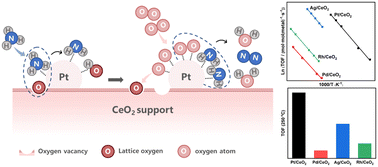Specific reactivity of 4d and 5d transition metals supported over CeO2 for ammonia oxidation†
Abstract
Optimizing NH3 oxidation activity and N2 selectivity remains a challenge in selective catalytic oxidation of ammonia (NH3-SCO). Herein, a series of 4d (Pd, Ag, Rh) and 5d (Pt) transition metal catalysts were synthesized and loaded over a reducible CeO2 support and tested for NH3-SCO reactions. The catalytic results indicated that Pt/CeO2 catalysts outperformed the other supported metals with superior NH3 oxidation performance and N2 selectivity, which was related to the strong metal–support interaction (SMSI) with electron transfer from Pt metals to CeO2 supports. This could be ascribed to the Pt–O–Ce synergistic effects and the high Ce3+ concentration over the Pt/CeO2 catalysts. The strong interactions between Pt and CeO2 also improved the reducibility of Pt/CeO2 and promoted the activation of surface lattice oxygen participating in the NH3-SCO reaction. The rigorous kinetic studies elucidated the elementary steps for the NH3-SCO reaction, where surface lattice oxygen activated surface adsorbed NH3 to form an amide (–NH2) which is regarded as the rate-determining step of NH3 oxidation. In situ DRIFTS also confirmed that surface lattice oxygen as a reactant triggered the formation of reactive intermediates of –NH2, which were consumed to generate N2 and H2O at low temperatures.



 Please wait while we load your content...
Please wait while we load your content...